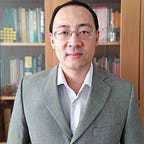Quantum Computing on the cover of Scientific American Brazil, June 2022!
I’m glad to see my all-time favorite theme starting to gain prominence, especially in Brazil!
While classical computing uses the bit, 0 or 1, the paradigm of quantum computing is the qubit (quantum bit), which can be 0, 1, or any superposition between both values. The superposition holds until the qubit is measured, and then the value collapses to 0 or 1 (remember Schrödinger’s cat, both alive and dead, until someone opens the box?).
In addition to superposition, another key property is entanglement: two qubits can become entangled so that they both collapse to the same value when measured — what Einstein called “Spooky action at a distance”.
The article focuses on error correction. Errors always exist and will always exist, due to communication noise, qubit decoherence, and so on. It is important to have a low error rate and handle errors that occur.
In classical computing, one way to do error correction is to insert redundancy. I can simply replicate the value: if I want to transmit 0, I can repeat the same three times (000). If, for some noise, the 000 turns 010, I have a way to know that there is something strange and correct the information.
Replicating qubits doesn’t work. A qubit cannot be cloned (the non-cloning theorem). The technique for error correction should be more subtle and indirect: using auxiliary qubits entangled with the data qubits, like a two-dimensional square grid, looking like a chessboard. This technique is called “surface code”.
However, the surface code is too dense, and the author (Zaira Nazario, from IBM) reports interference between qubits in IBM’s superconducting quantum computers.
Finally, the article comments on another setup between data qubits and auxiliary they are researching, the “heavy hex” layout. This one resembles a grid of hexagons, which has the advantage of being less dense than the chessboard layout, mitigating problems. It is state-of-the-art quantum error correction.
More than the technical content, it is great to see this topic being discussed in popular science journals.
See also:
